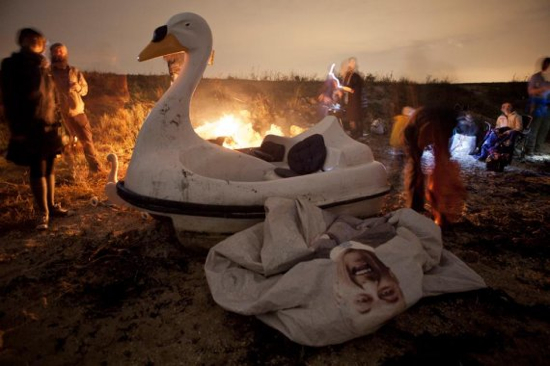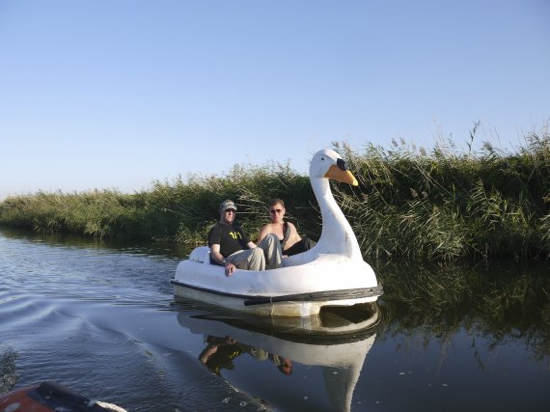The English coast: sunless sky, sea the colour of cement. Two middle-aged men, one wearing nothing but a pair of snug black Speedos, the other fully dressed in a beige jacket and some soggy chinos, are attempting to launch a giant, scuffed, white plastic swan onto the English Channel. It isn’t working. They push the swan out, the waves shove it back. They try again, the same thing happens. They are not deterred. They go away and return – this time with a miniature model of the swan and a bottle of wine. In between swigs, the men douse the model with the remaining wine, slashing the grey horizon with a gritty red. It looks like a sacrificial ceremony, of sorts: an entreaty to the elements, or the higher powers. But with alcohol, not blood; polycarbonate, not flesh. Pausing for breath, the Speedo man – now in a full suit – asks his chino-clad companion, "Do you think this’ll help, then?"
In September and October 2011 artist/filmmaker Andrew Kötting and writer/psychogeographer Iain Sinclair peddled a swan pedalo dubbed Edith (liberated, under the cover of nightfall, from her tethers at a seaside resort) a total of 160 miles from Hastings, East Sussex to Hackney, East London. The bizarre, bathetic scenes described above are from the documentary that Kötting made about this highly irregular journey. Disingenuously dismissed as “indecorous horseplay” by Sinclair, the whole thing may sound absurd. But then that, essentially, is the point.
Swandown is the third in a series of collaborations between Kötting and Sinclair. Inspired by the radical artistic movements of the earlier part of the 20th century (the Surrealists, and the later Situationists), as much as the performance artist Bas Jan Ader (who was lost at sea in 1975 while attempting to cross the Atlantic single-handed in a pocket cruiser for a piece called ‘In Search of the Miraculous’), it has been summarised as "a Dada performance and cultural investigation, an artistically riotous response to the corporate spirit dominating London in Olympics year." As anyone familiar with his work will know, Sinclair is a fervent hater of the 2012 Olympics, regarding them as the epitome of "mindless futurism" and the product of "dodgy capital": a dreadful affair orchestrated by greedy, cultural and architectural vandals. While ‘London 2012’ has one corporate, copyrighted image of the capital to push, he and Kötting have other, alternative ones to peddle.
The "waterbound pilgrimage" that they embarked upon was, primarily, an act of psychogeographical “ordnance and surveying” – with the aim of re-discovering and re-mapping a forgotten London – a London buried by councils and committees who brayed about one "legacy" while in the act of bulldozing another. To elaborate, but not necessary elucidate: in the film, Sinclair makes the far-out assertion that in travelling along the city’s history-clogged waterways, he and his companion have become “flesh radios” – able to tune into the historical, literary, and political echoes of the past, the “cultural unconscious” of the ancient capital and its outer edges. Throughout his leg of the journey (halfway through, he is is airlifted away to do a reading tour in America, leaving Kötting to complete the thing alone), he continuously expounds on its connection to Dickens, to Leda, and to Joseph Conrad.
Sinclair’s constant oral confabulation is reflected in Kötting’s dynamic directorial style, which distorts the viewer’s sense of a chronology of events. The past – part imagined, part real – ruptures into the present before our eyes and ears. Archive film of people paddling in the sea and working on the waterways, and a staged scene involving an Ophelia-like woman climbing into the water, are intercut with footage of the swan’s progress. The soundtrack layers folk songs and swelling orchestral music with recordings of Kötting, Sinclair et al, wisecracking and reading poetry into a crackling walkie-talkie, these elements floating over one another like river-buoyed debris.
What’s more, extracts from Werner Herzog’s Fitzcarraldo and the documentary Les Blank made about it, Burden Of Dreams, are featured throughout – presumably to minimise the risk that the viewer might miss the parallels between these films and the one they are watching. The pedalo’s painfully incremental progress towards Hackney is the parodic equivalent of trying to winch an opera house over a mountain. Swandown is also overburdened with references to Heart Of Darkness – the work that inspired Herzog’s film. Conrad’s novel begins in the heart of the ‘civilised’ world, at the mouth of the Thames, on a boat which will travel out into the horror of the ‘dark continent’. Kötting and Sinclair turn that conceit on its head, travelling into London, deep into its own heart of darkness: the Olympics. This arrival is signalled by a dull, depressing clang, and an abrasive scraping of plastic on metal, as Edith’s way is finally blocked by official barriers.

But as much as Swandown is about dredging up, like riverweed, submerged myths, it’s about making new ones too. Sinclair’s apparently compulsive allusion-making is, in part, a way of weaving himself, Kötting and Edith, into the stories through which they’re swanning. An atmosphere of history in the making is created by Kötting’s use of a pinhole camera, which gives the photographs he inserts into the feature a ghostly, faded appearance: time-sealed, before any time has yet passed. There’s also a sense that material is meticulously being recorded, collected for posterity. Field notes, plans, maps and photographs from the swan voyage have been curated into an exhibition in Dilston Grove gallery, South East London. And even digital flotsam and jetsam, including email correspondence, film clips and a list of birds spotted, have been uploaded onto a specially constructed website . All of this stuff resembles the rubble from an archaeological dig – amassed together, awaiting the arrival of someone who will sort and spin a new story from it.
Yet Swandown somehow manages to avoid coming across as if it takes itself too seriously, achieving a balance between comic and contemplative that’s easy and enjoyable to watch. While Kötting’s direction serves to swell Sinclair’s rambling ideas, his actual presence in the film punctures and deflates them whenever they threaten to become unbearable. Kötting enthusiastically, repeatedly, plunging into beer can-cluttered water in his suit is the perfect counterweight to Sinclair’s pretension. As are the series of guest pedallers who join the trek at various points along the way: Alan Moore, Stewart Lee, Dudley Sutton, Dr Mark Lythgoe and Marcia Farquhar. They all peddle away enthusiastically enough, but each newcomer seems as baffled as the last one about what they are pedalling for.
In fact, Stewart Lee isn’t convinced that the orchestrators of the project have a much more definite idea either, musing: "Iain Sinclair is taking a mythological symbol to the Olympics, maybe to remind the Olympics what they are about? Whereas I think Andrew Kötting just sort of sees what happens and then reverse engineers the meaning after he has collated the events." Almost definitely so, Stewart. But then, it’s not the destination, but the journey that counts.



